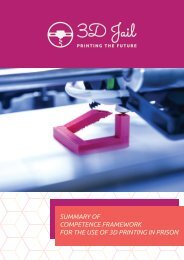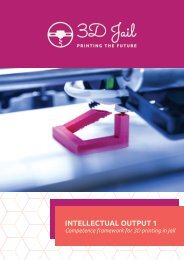Training models for the use of 3D printing technology in prison
3D Jail project further involves a training program for the training and development of trainers who are going to deliver the training program for inmates. Trainers are required to have basic computer, CAM and CAD skills. For the training of the trainers has also been planned an in-service training program to cover information on general characteristics of penitentiary institutions and inmates, use of the e-learning portal, and 3D printing.
3D Jail project further involves a training program for the training and development of trainers who
are going to deliver the training program for inmates. Trainers are required to have basic computer,
CAM and CAD skills. For the training of the trainers has also been planned an in-service training
program to cover information on general characteristics of penitentiary institutions and inmates, use
of the e-learning portal, and 3D printing.
You also want an ePaper? Increase the reach of your titles
YUMPU automatically turns print PDFs into web optimized ePapers that Google loves.
One thing that would also help is to include a follow-up in the online training. The idea is that
trainees would be given enough time, maybe a few weeks, to experiment with what they have
learned after the end of the 3D printing seminars and gather questions. A follow-up would be
targeted to address these questions or any issues that arise.
Development of a screening tool for the prisoners: to include a final test and a certification
In addition, links of the printing workshop to the outside market could contribute so that there
are tangible goals for the inmates. That would bring motivation to the inmates and profoundly
help them reintegrate after their release.
Given the impact of COVID 19 in the course planning period, it is clear that face-to-face beside
distance education.
This course, especially for prisoners, needs all the material and equipment needed to succeed
Where possible, it would be better to close the door of the room where the lesson takes place.
The inmates must strictly follow the rules, otherwise they cannot focus on the lessons.
From a methodological point of view the course can be improved by shortening the theoretical
part as much as possible: search for a field of “problems”, let the participants identify solutions
and how to solve them.
More practical, lab experiments. The training should last more days and hours in order to gain
more experience
The importance of learning to conclude the course with the printing of an object is underlined
after the experience
Hints to guide the course implementation
In summary, the following indications emerge in order to improve the development of future courses:
1. The Canvas platform is very appreciated, but it is recommended to provide some further
guidance, perhaps a brief initial training moment, to explain how to use it offline. It is also
noted that materials uploaded to the platform are unsuitable for weak connections. This is
linked to the fact that to carry out the course you absolutely need internet access and also a
good connection.
2. With respect to the implementation of the course contents in Canvas each partner will have
full powers to be able to modify, add and update the materials. Always on the platform will
also have the opportunity to share its changes with other partners.
3. It is clear from the results of the courses realized that the duration of the courses, the amount
of deepening, depends mainly on the preparation of incoming trainees, so depends on
whether or not to deepen the basic knowledge on the computer.
4. The experimentation of the courses has accidentally impacted with the pandemic and its
restrictions from which however it emerges clear the indication that the courses in presence
are much more effective than those at a distance that are not recommended especially those
aimed at prisoners.
5. The COVID 19 has often hindered the courses also with regard to the procurement of
equipment and useful materials, in particular the 3D printer, making it clear that the course
experimented depends largely on the presence of the right machines and equipment.
6. With respect to the implementation of the course, it is also stressed that, especially in distance
training, the theory alone risks being very drowsy. It is therefore advisable to develop training
modules where the theoretical part, as short as possible, are followed by problem solving
dynamics where the trainee is the protagonist of the solution. It is also suggested an extension
of the duration of the course for the benefit of an increase in exercises. In particular, the
inclusion of 3D printing of the object that the trainees have designed that for them has a
strong motivational value is strongly encouraged.
3DJail printing the future – IO2
28





